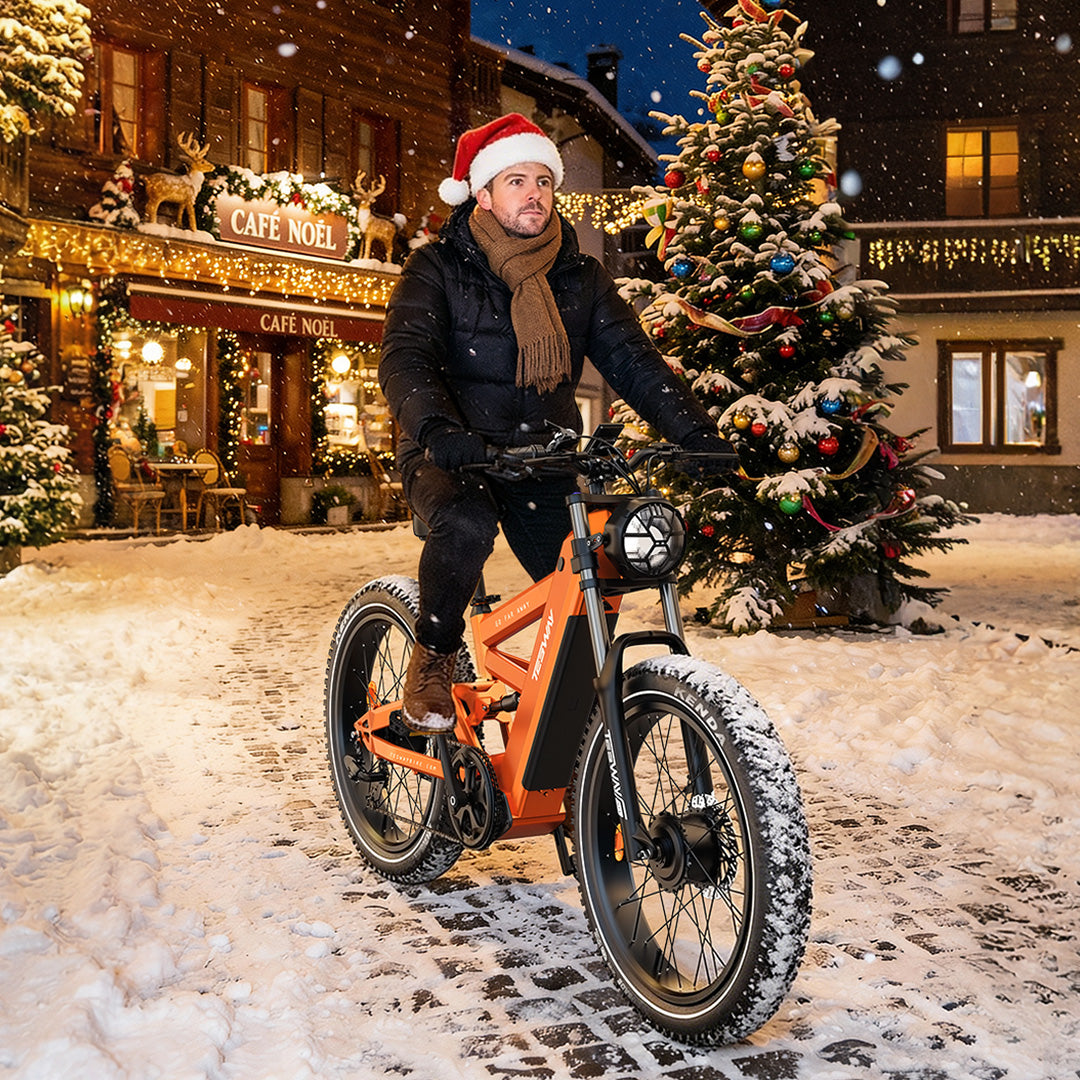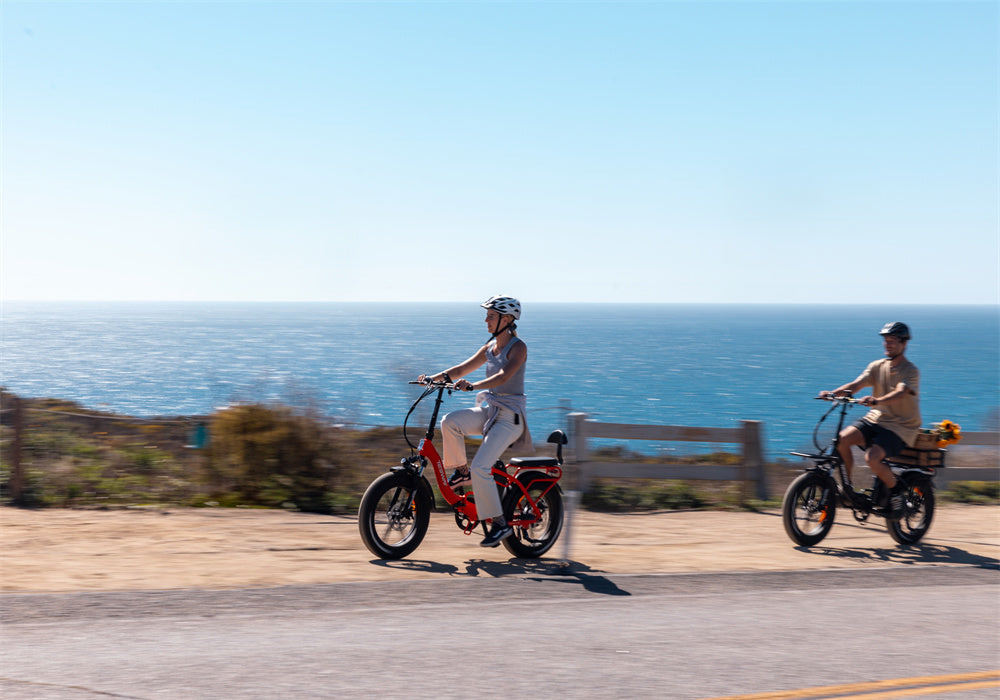Electric bikes have taken the cycling world by storm.
Offering a combination of traditional pedaling with electric motor assistance, they give riders the best of both worlds: a classic workout and a smooth, effortless ride.
Can you actually pedal an electric bike like you would a regular bicycle?
Make way, Tesway coming through.
On tough trails or city streets, Tesway folding ebikes, fat tire ebiks and commuting ebikes quietly take the lead with smooth power and effortless handling.
How Does Pedal Assist Work
At its core, an e-bike is a bicycle equipped with an electric motor and battery, designed to assist the rider’s pedaling efforts.
This assistance can vary depending on the pedal-assist mode, which allows the rider to control how much help they want from the motor.
Some e-bikes also have a throttle function, meaning you don’t have to pedal at all to move. This is where the key distinction comes into play.
Most electric bikes come with a Pedal Assist System (PAS), which means the motor kicks in when you start pedaling.
The harder you pedal, the more the motor assists you.
Think of it as adding turbo to your pedaling effort.
When you push down on the pedals, sensors on the bike measure the force and send signals to the motor, which then responds with a boost.
PAS lies in its adjustability—whether you want minimal assistance to break a sweat or maximum power for a stress-free cruise, it’s all within your control.
Pedal assist is typically divided into several levels.
Low settings provide a modest amount of assistance, letting you pedal more while still benefiting from a little extra push.
High levels make the ride almost effortless, letting the motor take over most of the work.
Most e-bikes come with 3 to 5 levels of assistance, allowing you to fine-tune your ride for different terrains or your energy levels.
Throttle Mode vs. Pedal Assist
Some e-bikes are equipped with a throttle, which lets you engage the motor without pedaling at all.
This is a popular feature for riders who want the flexibility to choose between pedaling and cruising.
While this mode is incredibly convenient, especially for commuting or short rides around town, it drains the battery faster than pedal assist.
In contrast, PAS requires pedaling, but you get more range out of the battery.
If you’re looking for a workout while still getting help from the motor, pedal assist is the way to go.

SEE ALSO How to Ride an Ebike the RIGHT and EASY Way [Step by Step for Beginners]
Can You Pedal Without Assistance
Absolutely. In fact, many e-bike enthusiasts prefer to pedal without the electric motor on, especially on flat terrain or when they’re in the mood for a good workout.
In these cases, the electric bike behaves much like a traditional bicycle, albeit a bit heavier due to the added motor and battery.
When the motor is turned off, the bike's weight does require more effort to pedal, especially on inclines.
If you're looking for a versatile ride, being able to turn off the motor and go purely manual is one of the perks of an e-bike.
For many riders, the ability to choose whether to engage the motor is one of the biggest advantages of e-bikes.
When you're facing a long climb or a headwind, you can rely on the motor to help.
But when you’re coasting on flat terrain or trying to get some exercise, turning off the motor allows you to get a more traditional cycling experience.
This makes electric bikes incredibly adaptable for various fitness levels and riding goals.

How Hard is It to Pedal an E-Bike Without Power
The weight of the e-bike—generally between 40 to 70 pounds—means it’s heavier than a traditional bike.
Naturally, this makes pedaling without assistance slightly more challenging, especially on slopes or long rides.
However, with pedal assist modes, the burden of the bike's weight is easily mitigated.
The additional weight can be barely noticeable when you're cruising along with motor support, but riders should be aware that it's still a factor if they choose to ride without motorized help.
Even without assistance, pedaling an e-bike is far from impossible. Most modern e-bikes are designed with efficient gearing systems, like Shimano or SRAM, which help distribute your effort across various terrains.
These gears allow you to shift into a lower setting when climbing or facing a headwind, reducing the amount of effort you need to exert.
However, because of the added weight, many riders opt for at least a minimal level of pedal assist during more challenging sections of their ride.

Benefits of Pedaling an Electric Bike
Pedaling your e-bike offers several benefits, especially for those concerned about physical fitness.
The more you pedal, the more calories you burn, the more you engage your muscles, and the better your cardiovascular health becomes.
E-bikes provide an excellent opportunity for people who may otherwise struggle with traditional cycling due to age, fitness levels, or physical limitations.
Pedal-assist can gradually increase your stamina, helping you go longer distances while keeping you in control of your exertion levels.
The Fitness Potential of E-Bikes
Despite the assistance provided by the motor, pedaling an electric bike can still be an effective workout.
By adjusting the pedal assist level, you can control the intensity of your ride.
At lower levels, you’ll be doing more of the work yourself, increasing your heart rate and strengthening your legs.
This makes e-bikes an excellent option for riders who want to combine the convenience of motorized support with the health benefits of traditional cycling.
Studies have shown that riding an e-bike can burn up to 75% of the calories that would be burned on a traditional bike, especially when pedal assist is kept at a low to moderate level.
Additionally, because riders can cover longer distances on an e-bike, they tend to cycle more frequently than they would on a regular bike, leading to greater overall fitness gains.

Pedaling for Range and Battery Conservation
One often overlooked benefit of pedaling your electric bike is how it conserves battery power.
Pedal-assist modes use less battery than throttle-only modes, meaning the more you pedal, the longer your battery will last.
On flat surfaces, you can often reduce the level of pedal-assist or turn it off entirely to save energy.
This becomes particularly useful for those long weekend rides where you want to maximize your range.
Many e-bike manufacturers recommend a combination of pedaling and motor use for optimal performance.
Riders can conserve battery life by only using the motor during tough climbs or when they’re fatigued.
This not only extends the range of the bike but also ensures that the rider gets a good workout.
Some higher-end models even come with regenerative braking, which helps to recharge the battery slightly when you coast downhill or apply the brakes.
E-Bikes and Different Riding Modes: How They Affect Pedaling
Electric bikes generally come with multiple riding modes, allowing riders to choose the right balance of pedal power and electric assistance.
Full-Pedal Mode (No Assistance)
This mode is similar to a regular bike—no electric assistance, and you’re completely responsible for propelling the bike. It’s ideal for fitness enthusiasts or anyone who wants to maximize the calorie-burning benefits of their ride. While the bike's additional weight can make it more challenging than a traditional bicycle, full-pedal mode offers a pure, unassisted cycling experience.
Low-Pedal Assist
This mode gives a small amount of help from the motor, making it easier to pedal but still requiring some effort.
It’s a great option for light workouts, casual commutes, or when you're going up a slight incline.
By engaging the motor minimally, you can maintain a higher level of exertion, which contributes to muscle strengthening and endurance building while keeping fatigue at bay.
High-Pedal Assist
With high-pedal assist, you’re still pedaling, but the motor does a lot of the heavy lifting.
This is especially useful for tackling steep hills or maintaining a higher speed on challenging terrain without breaking a sweat.
In this mode, you’ll still engage your muscles, but the effort required is significantly reduced, making it a popular choice for riders with joint issues or those looking to avoid overexertion.
Throttle Mode (No Pedaling Required)
This mode allows you to ride without pedaling at all—just twist the throttle, and off you go.
While this offers maximum convenience, it also uses up the most battery power.
If you're not keen on pedaling but want to save your battery, a balance between throttle and pedal-assist is the way to go.
Many riders switch between throttle and pedal assist, using the throttle for short bursts or when they need a break from pedaling.
Pedaling an Electric Bike on Different Terrains
One of the best aspects of an e-bike is its versatility, allowing you to ride over various types of terrain with ease. However, how much you need to pedal depends on the terrain you're covering.
Urban Roads
In cities, pedaling an e-bike is often a breeze.
Flat roads combined with stop-and-go traffic make electric assistance extremely handy.
You’ll likely be using a lower level of pedal assist, or none at all if the terrain is consistently flat.
Urban riding often involves frequent stops at traffic lights or for pedestrians, so having pedal assist can help you regain momentum quickly when starting from a complete stop.
Hilly Terrain
This is where e-bikes truly shine.
Climbing hills on a traditional bike can be grueling, but with an e-bike’s pedal-assist system, even the steepest inclines become manageable.
If you're still pedaling, you’ll feel the burn, but the motor will smooth out the experience, making those otherwise daunting hills feel like a gentle slope.
With high-pedal assist, you can maintain a steady pace without exhausting yourself, while low-pedal assist allows for more of a workout as you climb.
Many e-bikes are equipped with torque sensors, which adjust the level of assistance based on how hard you pedal, ensuring a more natural feel when scaling steep hills.
Off-Road Trails
For those who like adventure, e-bikes equipped with fat tires or mountain bike components make off-road biking accessible for everyone.
Pedaling on rough terrain like dirt paths, gravel roads, or forest trails can be challenging, even for experienced cyclists.
But with the motor’s assistance, you can tackle uneven surfaces with ease.
The motor provides the power to navigate through obstacles, while pedaling helps maintain control and balance.
Fat-tire e-bikes, in particular, offer extra stability and cushioning, which is ideal for absorbing shocks from rocks and bumps.
Pedal assist helps ensure that you don’t get stuck in loose gravel or sand, as the extra power helps keep the tires moving.
Even though the motor will do much of the hard work, you’ll still get a workout by maintaining balance and steering through uneven terrain.
Riders who enjoy off-road biking will appreciate the combination of manual pedaling with the reliability of an electric motor when facing tougher trails.

Pedal Power vs. Motor Power: The Ideal Combination
The beauty of an electric bike lies in its hybrid nature.
By balancing pedal power with motor assistance, you get the perfect combination of effort and ease.
Whether you’re commuting, exploring, or exercising, being able to choose how much you want to pedal makes e-bikes an incredibly versatile option for riders of all skill levels.
Commuting with an E-Bike
For many, an e-bike is the perfect commuting tool, combining speed with energy efficiency.
Pedaling your way to work in the morning can provide a refreshing start to your day, while the motor assistance ensures you don’t arrive at the office drenched in sweat.
When traffic picks up, you can rely on the throttle or pedal-assist mode to help you navigate through congested roads quickly and with minimal effort.
Many e-bike commuters also appreciate the fact that they can maintain higher speeds than traditional bicycles, especially when riding in high-pedal assist mode or using the throttle.
This makes longer commutes more manageable, as you can cover more ground in less time.
You can choose to pedal lightly or heavily depending on how much energy you want to conserve throughout the day.
Fitness and Recreation
Pedaling an electric bike for fitness is a growing trend among health-conscious individuals.
The pedal-assist system allows you to customize the intensity of your workout, letting you increase your effort when you want to push yourself and rely on the motor when you need a break.
Whether you’re cycling for cardiovascular health, weight loss, or muscle toning, the flexibility offered by e-bikes makes them an excellent tool for all levels of fitness.
On longer rides, riders can alternate between pedal assist and throttle to avoid fatigue, ensuring they cover more miles without over-exertion.
Some e-bikes even come with built-in fitness tracking apps, allowing you to monitor your pedal power, calories burned, and distance traveled, giving you a comprehensive overview of your fitness progress.
The Environmental Impact of Pedaling an Electric Bike
Pedaling your e-bike doesn’t just benefit your health—it’s also a more eco-friendly mode of transportation.
Traditional cars emit harmful gases into the environment, while e-bikes have a significantly lower carbon footprint.
By choosing to pedal more often and rely less on the motor, you can further reduce your environmental impact.
Studies have shown that e-bikes can reduce greenhouse gas emissions by up to 90% compared to cars, making them a sustainable choice for both urban and rural transportation.
Even though e-bikes rely on electricity, the more you pedal, the less energy the motor needs to expend.
This means fewer battery charges, which translates to a longer battery lifespan and lower energy consumption.
By reducing the frequency of charging, riders can extend the life of their battery, decreasing the need for replacements and reducing e-waste.
In essence, the more you pedal, the more you contribute to a cleaner environment.
The Verdict
Without a doubt, pedaling an electric bike enhances your riding experience, combining fitness, convenience, and fun.
Whether you’re riding to work, exploring off-road paths, or climbing hills, being able to choose how much you want to pedal makes e-bikes an ideal option for riders of all abilities.
The flexibility of switching between manual pedaling and electric assistance ensures that you can tailor every ride to your mood, fitness level, and the terrain ahead.
Not only does it give you the freedom to ride further and faster, but it also offers a way to stay active, reduce your carbon footprint, and get more enjoyment out of every trip.
FAQs
How long does an e-bike battery typically last before needing replacement?
E-bike batteries generally last between 3 to 5 years, depending on usage, charging habits, and battery quality. Frequent full discharges and high temperatures can shorten battery life, while proper care and regular maintenance can extend it.
Can I ride an e-bike in the rain or wet conditions?
Yes, most e-bikes are designed to be water-resistant and can handle rain or wet conditions. However, it’s important to check the specific model’s water-resistance rating and avoid fully submerging the bike or riding through deep puddles to prevent damage.
Do I need a special license or insurance to ride an e-bike?
This depends on where you live. In many areas, no special license or insurance is required for e-bikes with a motor limit under 750W. However, laws vary by country or state, so it's best to check local regulations for specific e-bike requirements.








Share:
What Are the Benefits of Riding E-Bikes?
Guide to E-Bike Touring Across the Country